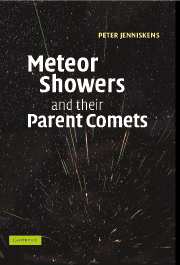Book contents
- Frontmatter
- Dedication
- Contents
- Preface
- Acknowledgements
- Part I Introduction
- Part II Parent bodies
- Part III Young streams from water vapor drag
- 11 Forecasting meteor storms from what planets do to dust trails
- 12 Meteor storm chasing
- 13 Meteor outbursts from long-period comets
- 14 Trapped: the Leonid Filament
- 15 The Leonid storms
- 16 The Ursids
- 17 The Perseids
- 18 Other Halley-type comets
- 19 Dust trails of Jupiter-family comets
- Part IV Young streams from comet fragmentation
- Part V Old streams and sporadic meteoroids
- Part VI Impact and relevance of meteor showers
- Appendix
- Tables
- Index
- Units and constants
18 - Other Halley-type comets
from Part III - Young streams from water vapor drag
Published online by Cambridge University Press: 05 July 2015
- Frontmatter
- Dedication
- Contents
- Preface
- Acknowledgements
- Part I Introduction
- Part II Parent bodies
- Part III Young streams from water vapor drag
- 11 Forecasting meteor storms from what planets do to dust trails
- 12 Meteor storm chasing
- 13 Meteor outbursts from long-period comets
- 14 Trapped: the Leonid Filament
- 15 The Leonid storms
- 16 The Ursids
- 17 The Perseids
- 18 Other Halley-type comets
- 19 Dust trails of Jupiter-family comets
- Part IV Young streams from comet fragmentation
- Part V Old streams and sporadic meteoroids
- Part VI Impact and relevance of meteor showers
- Appendix
- Tables
- Index
- Units and constants
Summary
Apart from the Leonids, Ursids, and Perseids, there are a handful of other known Halley-type comet induced showers with past meteor outbursts, and some that are not so well known. In addition, I will report here on an ongoing investigation into a mechanism of comet ejection peculiar to Halley-type comets and how that may manifest as meteor showers on Earth.
18.1 The Halley streams
The Orionid shower was among those discovered in the years following the 1833 Leonid storm. It is a relatively strong annual shower with a peak of ZHR = 25 around October 22. The parent is comet 1P/Halley itself, now in an orbit passing a far +0.151 AU from Earth.
Hence it came as a surprise when, in 1993, the most active and experienced visual observer of the Dutch Meteor Society, amateur astronomer Koen Miskotte, reported an outburst of meteors from the Orionid shower (Fig. 18.1). Observing under a good sky limiting magnitude Lm =+6.6m in the two nights of October 16/17 and 17/18 (peak at λ⊙ ∼204.5°), rates were 2–3 times higher than normal. In that second night, Koen saw a −5m Orionid fireball, another of −4m and two of −3m from R.A. = 90.3°, Decl. = 14.8°. This is very unusual since Orionids are quite faint (population index χ = 2.9) and as Koen recalls I had never seen Orionids brighter than −2 before in my career as a meteor observer. And I should know, because I watched this shower in seven previous years. Hans Betlem, observing from Sinderen in the eastern part of the Netherlands, confirmed the high activity. Some of these bright meteors were photographed, but only one from two sites simultaneously. That Orionid with a −5m end flare had a radiant at R.A. = 90.1±0.2°, Decl. =+15.4±0.2° and speed Vg = 67.5±0.7 km/s. Its orbit had a higher than usual perihelion distance at 0.613±0.013 AU (Table 7).
- Type
- Chapter
- Information
- Meteor Showers and their Parent Comets , pp. 301 - 320Publisher: Cambridge University PressPrint publication year: 2006



